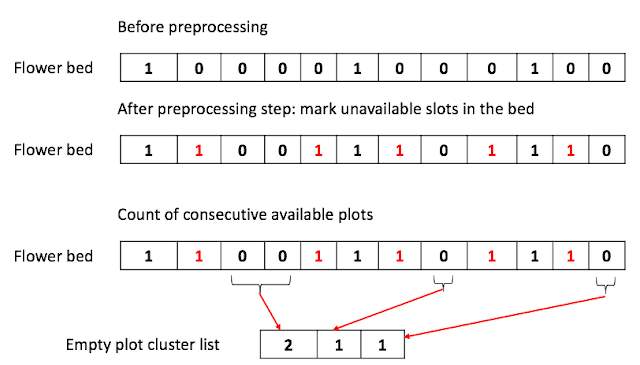Local MinMax problem [reviewed]
Problem
Given the list of numbers, find the local min or local maxLocal max or min is the number that exists between the first and last number.
For example,
1,2,3,4,3,2 => local max exists, which is 4
1,2,3,4,5,6,7 => No local max or local min exists
5,4,3,2,1 => No local max or local min exists
9,8,7,6,5,6,7,8,9 => local min exists, which is 5.
Challenging part is that your problem should run faster than O(N).
hint: all the numbers are increasing by 1 or decreasing by 1. There is no gap.
Here is the algorithm. There can be two cases that we need to consider.
1) Ascending numbers
No local min or max: The last number, A[N-1] should be the same as A[0] + N-1, where N is the length of the list.
A[0] + N -1 = A[N-1]
If not, there must be local max.
In that case, the local min can be calculated by the following formula
Local max = (A[0] + N-1 + A[N-1])/2
 |
| Figure 1. Local max |
As shown in Figure 1. if the numbers ascends to the end. A[0] + N-1 will be same as A+B.
However, there exists a local max. the last number in the array in A[N-1] is the same as A-B.
Therefore, (A[0] + N-1 + A[N-1])/2 = (A+B + A - B)/2 = 2A/2, thereby getting A.
2) Descending numbers
No local min or max: The last number in the array, A[N-1] should be the same as A[0]-(N-1), where N is the length of the list.
A[0] - (N-1) = A[N-1]
If not, there must be local min
In that case, the local min can be calculated by the following formula
Local max = (A[0] + N-1 + A[N-1])/2
 |
| Figure 2. Local min |
However, there exists a local min. the last number in the array in A[N-1] is the same as -A+B.
Therefore, (A[0] - N-1 + A[N-1])/2 = (-A-B - A + B)/2 = -2A/2, thereby getting -A.
Don't forget the fact that, A[0] > -A in the example.
Based on the algorithm discussed, the following implementation can be written.
If look at the formula carefully, it will result in the max or min number when there is no local min or local max exists.
UPDATE(2019-08-01): solved the problem again using binary search, which is practically faster than $O(N)$. However, if the numbers between 0 and N-1 are either up-down or down-up V shape. The above algorithm will work and will be O(1). Need to look closer.
Here is the solution in python.
Practice statistics
10:00: to find the algorithm using a binary search
11:43: to write up the code and test case (No bug was found !!! yeah ...)
01:10: to write up test cases.
UPDATE(2019-08-01): Here is another solution running in $O(1)$ via simple computation to find the middle value.
This question could be just a brain teaser than algorithm question.
Practice statistics
10:00: to write the code with algorithm
02:00: to fix the logical error returning position instead of value and switching min and max

Comments
Post a Comment